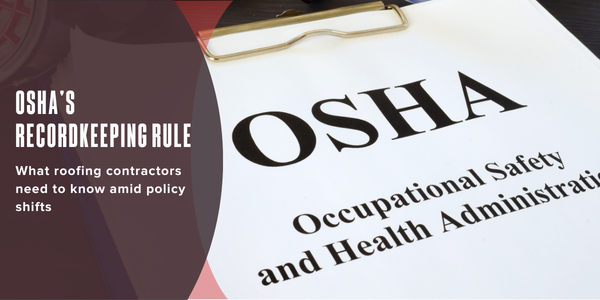UP TO THE MINUTE
OSHA's recordkeeping rule
November 10, 2025 at 6:00 a.m.By Cotney Consulting Group.
What roofing contractors need to know amid policy shifts.
Roofing contractors have long managed safety logs, injury reports and OSHA documentation in their daily operations. But in 2024, OSHA raised the stakes. Its expanded electronic recordkeeping rule brought a new era of data transparency and compliance expectations, reshaping how contractors manage their safety records and respond to enforcement.
In 2025, with a new administration signaling regulatory rollbacks and broader deregulation efforts, many contractors ask the same question: Do we still need to comply?
The short answer is yes, at least for now. The rule remains in force, and roofing companies must continue meeting the electronic recordkeeping requirements until official changes are finalized.
A rule that changed the game
OSHA’s final rule, which took effect in January 2024, expanded electronic submission requirements for injury and illness data. Roofing contractors and other high-hazard industry employers with 100 or more employees must now electronically submit data from three key forms:
- Form 300: Log of Work-Related Injuries and Illnesses
- Form 301: Injury and Illness Incident Report
- Form 300A: Summary of Work-Related Injuries and Illnesses
Previously, only the annual summary (Form 300A) was required. The expanded rule allows OSHA to collect and analyze detailed data to identify injury patterns and more effectively target inspections. The agency’s stated goal was “transparency and prevention.”
It introduced a new reality for contractors: your safety record is now part of the public domain. OSHA’s database makes this data searchable by industry, region and company. That means clients, insurers and competitors can see more than ever.
Why it still matters in 2025
Even as the Trump administration signals its intent to review or modify OSHA’s recent regulations, no formal rollback has been enacted. The rule remains fully enforceable until rescinded or amended through the official rulemaking process.
That means roofing contractors must submit required forms by the annual deadline, maintain accurate digital records and ensure data integrity. OSHA continues to treat recordkeeping as one of its highest enforcement priorities, and failure to comply can lead to citations, fines and increased inspection scrutiny.
Contractors who assume the rule is “on hold” risk being caught out of compliance, a costly mistake that can damage safety ratings and reputation.
The new administration’s direction
Under the Trump administration’s renewed focus on deregulation, OSHA is re-evaluating several rules enacted during the previous administration, including the expanded electronic recordkeeping rule. Early signals suggest the agency may consider scaling back the scope of data submission — possibly removing the detailed Form 300 and 301 reporting requirement for large employers and returning to the older system that required only Form 300A summaries.
While those discussions are ongoing, there’s no set timeline. Industry analysts note that OSHA’s leadership has publicly stated that the agency will continue collecting data until new regulations are adopted.
For contractors, this means maintaining a “stay compliant, stay ready” strategy, fulfilling all current requirements and monitoring policy developments through trade associations and legal advisors.
Practical steps for roofing contractors
Regardless of future changes, now is the time to modernize your safety recordkeeping. A proactive digital system will keep you compliant, streamline internal safety management andimprove your company’s image.
Here’s what contractors should focus on in 2025:
- Stay current on requirements: Review OSHA’s electronic submission deadlines and confirm whether your company’s NAICS code qualifies as a “high-hazard” industry. Roofing (classified under construction) is included in most cases.
- Maintain data accuracy: Every entry matters. Review incident reports for accuracy before submission. If OSHA cross-checks data during inspections, misclassifying injuries or failing to include a case can lead to compliance issues.
- Protect data security: OSHA removes personal identifiers from publicly available data, but your internal systems should still comply with privacy and cybersecurity best practices. Limit access to authorized staff and secure digital files.
- Audit and improve: Use your safety data to drive improvement. Review trends quarterly if falls, sprains or tool-related injuries appear repeatedly, build targeted training around them.
- Monitor for policy updates: Follow updates from OSHA, NRCA and professional safety organizations. If the rule is amended, you’ll be prepared to adapt quickly instead of scrambling at the last minute.
Why leadership matters more than ever
Regulatory changes come and go, but a company’s safety culture should remain steady. Whether data is stored electronically or on paper, roofing contractors with strong internal communication, training and leadership always stay ahead.
Leaders set the tone. When ownership and field management view recordkeeping as more than paperwork, it is a real accountability measure and crews notice. They report incidents honestly, follow procedures and understand that safety documentation protects everyone, not just the company.
A transparent safety culture also strengthens client confidence. More developers and property owners now review contractors’ OSHA data as part of prequalification. Maintaining accurate, clean records is as much a business advantage as it is a compliance requirement.
Looking ahead
It’s entirely possible that the current rule could be revised or scaled back in the next year or two. However, history has shown that competent contractors never relax their safety standards when regulations loosen. They use these moments to refine internal systems, reinforce training and double down on consistency.
While Washington debates policy, what happens on the roof really counts. Accurate documentation, continuous improvement and strong leadership remain the cornerstones of a professional, compliant roofing company, no matter who’s in office.
OSHA’s expanded electronic recordkeeping rule remains in effect as of 2025. Roofing contractors should stay compliant, organized and alert to potential policy shifts.
The political climate may change, but accountability should not. In the end, recordkeeping isn’t just about what you submit to OSHA; it’s about what you learn from your data. The companies that embrace that mindset will stay ahead, regardless of how the regulatory wind blows.
Learn more about Cotney Consulting Group in their Coffee Shop Directory or visit www.cotneyconsulting.com.




















Comments
Leave a Reply
Have an account? Login to leave a comment!
Sign In